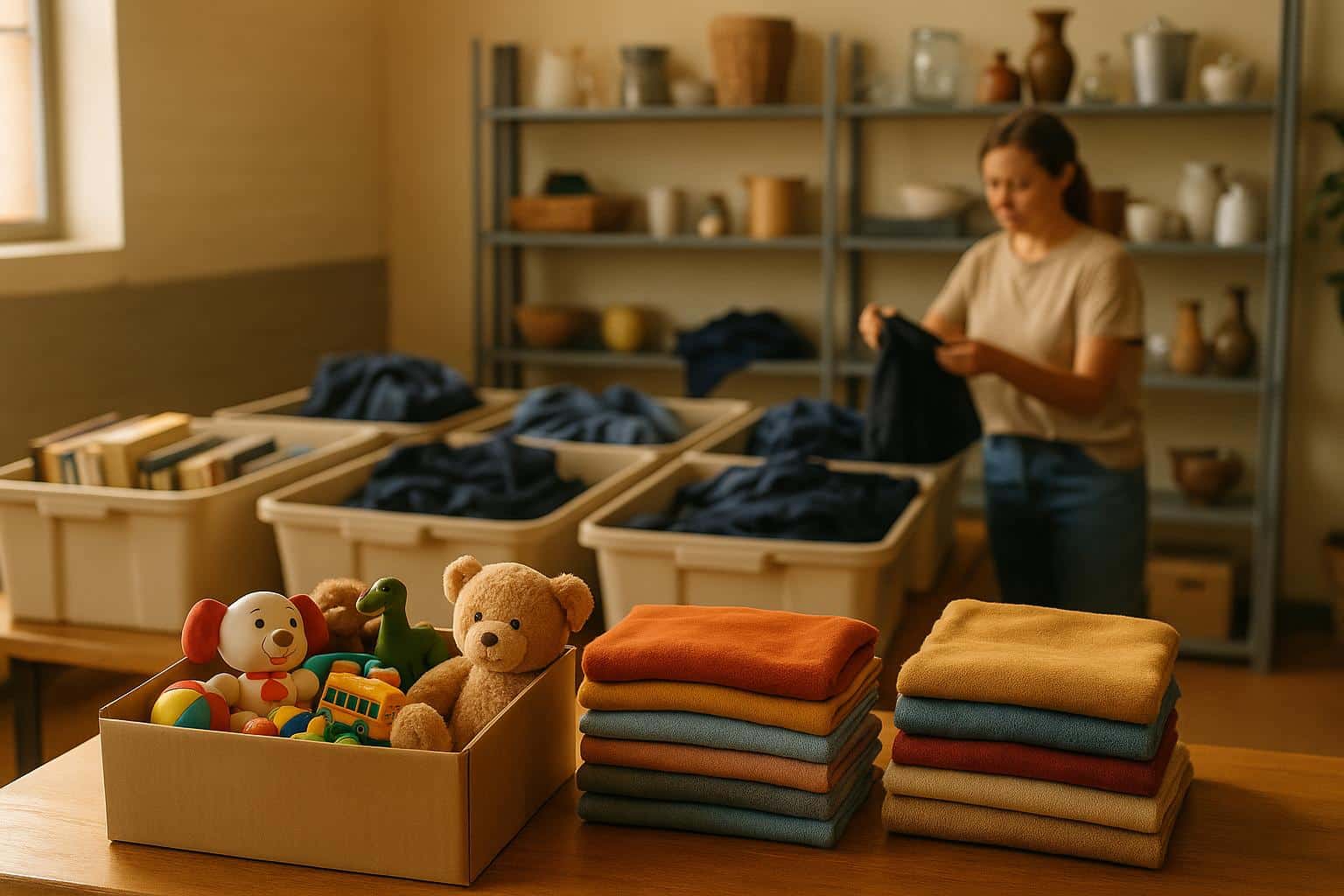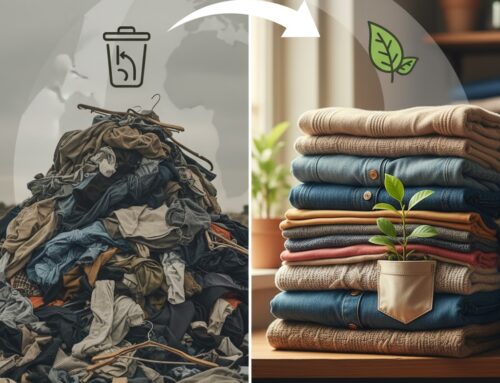When thrift store items don’t sell, they aren’t simply thrown away. Instead, stores follow a system to reduce waste and support communities. Here’s a quick breakdown:
- Sales Floor Rotation: Items stay on shelves for about four weeks. Unsold items are discounted, moved to clearance, or taken off the floor.
- Redistribution: Items may be sent to other store locations or sold through outlets and auctions.
- Recycling: Unsellable textiles are recycled into materials like fibers, rags, or insulation.
- Secondary Markets: Some items are sold in bulk to salvage businesses or exported overseas.
- Disposal: Only items that are unsafe, damaged, or contaminated are sent to landfills, but this is a last resort.
Thrift stores use these methods to minimize waste, generate revenue for community programs, and extend the life of donated goods. Every step ensures that as little as possible ends up in landfills.
How Thrift Stores Sort and Manage Inventory
Creating those neat and organized displays at thrift stores takes more than meets the eye. Stores like City Thrift rely on a well-oiled system to process donations and manage inventory, ensuring smooth operations and a steady flow of items for shoppers.
How Donations Are First Sorted
When donations arrive, they go through a detailed sorting process. Staff categorize items – clothing, books, housewares, furniture – and inspect them for quality and value. This involves checking for damage, stains, or excessive wear that might make items unsuitable for sale. At the same time, they assess items for unique qualities, such as vintage or collectible value, which could make them stand out.
This initial sorting acts as a critical filter in managing inventory. For example, one thrift store reported that 40% of donated clothing is immediately sent to the baler due to poor quality or stains. In 2023, Goodwill even stopped stocking Walmart-brand clothing on their sales floor, deeming these items unfit for resale after their first owner. Instead, they send these directly for recycling. Efficient sorting like this ensures that only sellable items reach the shelves, allowing stores like City Thrift to maximize their community support efforts.
Moving Unsold Items Off the Sales Floor
To keep inventory fresh and attract repeat customers, thrift stores use rotation systems. Items typically stay on the sales floor for about four weeks. After that, they’re either moved to clearance sections, marked down, or removed entirely.
Sell-through rates – how much of the inventory sells – can vary widely. Dee Brooks, Team Leader for Clothing at Gift and Thrift, shared some insight into their process:
Our average a week that we put out is about 3,500 pieces, and our normal bale is below 250. So it’s very low percentage that we bale.
Meanwhile, Lisa Sexton, Eastern District Manager for Goodwill, highlighted differences across locations:
This store has about a set of 75% overall sell through rate. And as a company we’re at about a 53% average sell through rate.
To increase turnover, stores rely on strategies like sales, discounts, bundles, and seasonal promotions. The goal is to strike a balance between processing new donations and clearing out older stock. Stores that manage this balance well can significantly reduce the amount of unsold inventory that ends up needing recycling, redistribution, or disposal. City Thrift’s methods exemplify how efficient inventory management supports their broader mission of giving back to the community. These practices also streamline the redistribution of unsold items, ensuring nothing goes to waste unnecessarily.
Where Unsold Items Go Next
When thrift stores can’t sell donated items, they don’t immediately head for recycling or the landfill. Instead, these items are given a second (or sometimes third) chance through various redistribution and resale strategies. Let’s take a closer look at how stores extend the life of unsold goods through internal transfers and secondary markets.
Sending Items to Other Store Locations
Many thrift store chains with multiple locations have a clever way of dealing with unsold items: they simply move them to a different store. What doesn’t sell in one area might be exactly what shoppers are searching for in another. By redistributing inventory, these stores cater to the unique tastes and needs of local communities.
For larger organizations, this process is carefully coordinated through inventory systems to ensure that stock levels are balanced across locations. In some cases, stores even purchase inventory from other branches to keep their shelves full. For instance, Goodwill Industries of Wayne and Holmes Counties sometimes buys donated goods from larger Goodwill branches to replenish their local stock and fund their programs. But when this internal reshuffling doesn’t clear the shelves, stores turn to other avenues.
Selling to Other Markets
If redistribution within the organization isn’t enough, thrift stores tap into secondary sales channels. Goodwill, for example, has a tiered system for unsold items. First, they’re sent to Goodwill Outlet stores, where shoppers can buy items by the pound for just $0.99. If they still don’t sell, the next stop might be Goodwill Auctions, where large “mystery” bins of unsold goods are sold for as little as $35 each.
Thrift stores also partner with salvage businesses that buy unsold goods in bulk at discounted rates and then distribute them through their networks. Some of these items even make their way into overseas markets, giving them yet another opportunity to find a new home.
As Atticus Firey, Director of Donations Development for The Salvation Army’s Adult Rehabilitation Center (ARC) Command in the Western Territory, explains:
If unsold in the store, we refer to it as a ragout. It returns to our distribution center, where we decide its next step.
The scale of these secondary markets is massive. For example, around 700,000 tons of used clothing are exported overseas every year. But this practice isn’t without its critics. Katrina Caspelich, Chief Marketing Officer for Remake, highlights a key concern:
When our used clothes get sent abroad, their sales can compete with other local merchants and textile industries in the area, and that competition can put financial pressure on those who may already be struggling to make a profit.
Despite the challenges, selling to secondary markets helps thrift stores avoid disposal costs and generate revenue. That income is vital for funding programs aimed at addressing homelessness and poverty. Stores like City Thrift use the money from these sales to support their community-focused missions. With only about 10% of donations ever making it to the sales floor, these secondary market relationships are critical for managing the overwhelming volume of goods and staying financially sustainable.
Recycling and Reusing Unsold Items
When thrift stores run out of resale options, they often turn to recycling and repurposing programs to keep items from ending up in landfills. These initiatives transform unwanted goods into materials or products that can still serve a purpose. Let’s dive into how these efforts breathe new life into unsold items.
How Clothing Gets Recycled
Recycling textiles starts with breaking down fabrics for reuse. First, items are sorted by material and color, which eliminates the need for re-dyeing, saving both energy and dye resources. Hardware like zippers and buttons is removed using magnets or by hand.
For natural fibers such as cotton and wool, the process involves shredding the textiles and carding the fibers to prepare them for spinning into new threads. Synthetic fabrics like polyester and acrylic go through a different route: they’re processed into polyester chips, melted, and spun into new fibers. Mixed-material garments present a unique challenge, often requiring chemical recycling to separate components using specialized additives. Some recyclers are even using advanced techniques, like melting stitching threads or employing industrial dismantling ovens, to simplify the process.
Companies are stepping up with creative solutions. Renewcell, based in Sweden, converts cotton and viscose into pulp that can be made into new cellulose fibers, processing around 7,000 tons of textile waste every year. Similarly, Loopalife, a Dutch brand, collects textiles from sorting centers, strips out hardware, and mechanically recycles fibers. These fibers are then blended with new materials to produce yarn for fresh garments.
Turning Old Items into New Products
Beyond traditional recycling, unsold thrift store items are often repurposed into entirely new products. For example, clothing that’s no longer wearable can be turned into cleaning rags, furniture stuffing, or even building insulation. Wool garments may be shredded into a mulch-like material and spun into shoddy – a lower-grade thread used for items like relief blankets.
Big brands are also embracing these practices. Patagonia, for instance, creates clothing using reclaimed down, wool, and polyester, with labels and zippers made from up to 80% recycled materials. Similarly, Ooloop, a member of the Green Business Network, incorporates recycled wool, cashmere, cotton, and even fishing nets into its products, turning surplus materials into stylish new clothing.
These efforts highlight how unsold items can be reimagined and put to use in entirely different ways. Now, let’s take a closer look at how recycling and reusing stack up as strategies for managing these materials.
Recycling vs. Reusing: What Works Better
Recycling and reusing both play important roles, but they approach waste reduction differently. Reusing involves extending an item’s life in its current form, like turning an old shirt into cleaning rags. Recycling, on the other hand, breaks items down into raw materials, reducing the need for new resources.
Here’s a closer look at the pros and cons of each approach:
| Approach | Advantages | Drawbacks |
|---|---|---|
| Reusing | Extends the life of items with minimal processing; provides immediate use | Limited to certain uses; items will eventually need to be disposed of |
| Recycling | Creates new materials; reduces demand for virgin fibers; handles mixed materials | Energy-intensive; quality of recycled materials can degrade; limited clothing-to-clothing recycling |
Despite their challenges, both options are far better than incinerating or landfilling. Unfortunately, over 3 million tons of clothing are burned, and 10 million tons are discarded in landfills annually.
“If you think, ‘No one’s gonna want to wear this,’ still donate it to us, and we will get what we can out of it. We will find a place for it that, 95 percent of the time, is not in a landfill.” – Brent Hendricks, Executive Director of Global Neighborhood Thrift
The National Institute of Standards and Technology offers hope: while 85% of clothing ends up trashed or burned, the 15% that’s donated is almost entirely reused, with only about 5% ultimately being incinerated or landfilled. This donation-to-recycling pipeline plays a crucial role in cutting down textile waste.
These recycling and reuse initiatives align with the mission of organizations like City Thrift, which use unsold items to support community programs and reduce waste. By repurposing what would otherwise be discarded, they contribute to addressing issues like homelessness and poverty while promoting sustainability.
When Items Must Be Thrown Away
Even with the best intentions to recycle and repurpose, some donations are simply beyond saving. Thrift stores regularly face tough calls about what can stay and what has to go, balancing their mission to serve the community with practical concerns like safety, costs, and space.
What Makes Items Unsuitable for Reuse
Not all donations make it to the sales floor. Many items are rejected because they pose safety risks, can’t be cleaned effectively, or cost more to process than they’re worth. For example, only about 10% of donated clothing sells. The rest is redirected or discarded.
Items that are damaged, stained, or excessively worn usually don’t make the cut. A good rule of thumb? If you wouldn’t give it to a friend, it’s probably not sellable. Lisa Tempel, Vice President of the American Cancer Society‘s Discovery Shop enterprise, puts it this way:
“A good rule of thumb for donating to thrift stores is to give only what you would feel good about passing on to a friend or family member.”
Health and safety concerns also play a big role. Mattresses and box springs are often rejected due to bedbug risks, and car seats are typically turned away because there’s no way to confirm whether they’ve been in an accident. Baby gear must meet strict safety standards, and anything that’s been recalled or banned is automatically a no-go.
Contamination is another dealbreaker. Items covered in pet hair, stained with unknown substances, or heavily scented often require extensive cleaning. For instance, it can take three or more washes to remove strong perfume from a single garment. Because of this, items with overpowering odors are usually rejected.
Here’s a breakdown of commonly rejected items and why they don’t cut:
| Item Type | Common Problems | Reason for Rejection |
|---|---|---|
| Clothing | Stains, rips, strong odors, excessive wear | Unsellable; cleaning costs exceed value |
| Electronics | Non-functional, outdated, missing parts | Safety hazards, expensive to repair |
| Furniture | Broken legs, deep scratches, particleboard damage | Difficult to repair; space limitations |
| Household Items | Chipped dishes, scratched cookware, and opened personal care products | Safety risks, hygiene concerns |
Heather Steeves, spokesperson for Goodwill stores in Vermont and New Hampshire, shared that across 30 stores, disposing of unsellable donations costs Goodwill over $1 million annually in trash bills.
Once rejected, these items are sent to specialized disposal channels.
Safe and Responsible Disposal Methods
For items that are unsafe, contaminated, or too costly to process, thrift stores rely on certified disposal methods to handle them responsibly. This involves meticulous sorting and working with professional waste management companies to reduce environmental impact.
Hazardous materials – like propane tanks, insecticides, toxic substances, and used batteries – require specialized handling. Thrift stores partner with certified disposal companies to ensure these materials are processed safely and within legal guidelines.
Contaminated textiles pose another challenge. For instance, Goodwill sends about 5% of donated clothes directly to landfills, primarily due to issues like mildew. In Vermont, New Hampshire, and Maine alone, 30 Goodwill stores discarded over 13 million pounds of waste.
The financial burden of disposing of unsellable donations is significant. The Salvation Army in Australia, for example, spends $6 million annually on landfill fees, diverting funds away from its core mission of community support.
Some thrift stores are finding creative ways to deal with unsuitable items. For instance, Habitat for Humanity ReStore accepts broken appliances and scrap metal that other thrift stores might reject. Mande Butler, Senior Director of Special Programs at Habitat for Humanity International, explains:
“When unusable, broken, or unsellable items are donated, more resources are spent on disposing of those items than on items that can be sold.”
The problem isn’t just local – it’s global. In Ghana’s largest secondhand clothing market, 40% of imported clothes are discarded as waste, amounting to more than 110,000 pounds of clothing thrown away daily.
For organizations like City Thrift, responsible disposal is part of a broader mission. While their primary focus is supporting City Union Mission’s programs for homelessness and poverty relief, they also prioritize reducing waste and protecting the environment. By ensuring only safe, usable items move forward, City Thrift stays committed to both community health and environmental care.
How Unsold Items Help the Community
Thrift stores play a key role in supporting their communities by redistributing, recycling, or repurposing unsold items. The revenue generated from these efforts funds essential local programs and services, creating a continuous cycle of community support.
Funding Local Programs
The proceeds from thrift store sales – whether from bulk sales, textile recycling, or partnerships – help fund critical community initiatives. For instance, The Salvation Army uses this revenue to support its Adult Rehabilitation Centers, which provide spiritual, emotional, and social assistance to individuals facing challenges like substance abuse. As Atticus Firey from The Salvation Army puts it:
And the first step in that journey is for us to sell as much of that as we can in our thrift stores
Similarly, Fort Bend Women’s Center operates ThriftWise Resale Stores to support survivors of domestic violence and sexual assault. Each purchase contributes to programs offering shelter, counseling, and legal support.
America’s Thrift Stores takes a broader approach, giving over $3 million annually to charities like Make-A-Wish and Children’s Miracle Network through partnerships with organizations like Children’s Healthcare of Atlanta (CHoA). CEO Ken Sobaski emphasizes their mission:
Our mission as a company is To Give Back…
City Thrift also channels its funding to City Union Mission, supporting programs that address homelessness and poverty in the Kansas City area.
Ways Community Members Can Help
Community involvement plays a huge role in the success of these programs. Quality donations are the backbone of thrift store operations. By donating gently used clothing, furniture, toys, and household goods, individuals help ensure a steady supply of inventory for the stores.
Shopping at thrift stores is another impactful way to contribute. Every purchase – whether it’s a $2 shirt or a $50 piece of furniture – helps generate the revenue needed to improve sorting, processing, and redistribution efforts for unsold items.
City Thrift, for example, encourages local support in various ways. Residents can shop at their Kansas City area stores, donate items at local centers, volunteer their time, or make financial contributions. Each of these actions not only reduces waste but also reinvests resources into tackling pressing issues like homelessness and poverty. Through these combined efforts, communities can make a meaningful difference.
How Thrift Stores Complete the Cycle
Thrift stores play a key role in ensuring every donated item serves a purpose, even if it doesn’t sell right away. This final stage of the donation process ties together all the steps that came before, from sorting to redistribution, creating a full-circle approach that benefits both the community and the environment.
Here’s how it works: when items don’t sell in one location, they’re often sent to other stores where they might attract buyers. If they remain unsold, thrift stores find other ways to make use of them. Some items are sold in bulk to different markets or channeled into textile recycling programs, ensuring they don’t end up in landfills.
Many thrift stores also host special discount events to clear out older inventory. Others get creative by working with local artists and crafters who transform unsellable materials into new, useful items. Some even bundle unsellable textiles into “rag bags”, perfect for crafting, DIY projects, or messy tasks.
The environmental benefits of these efforts are impressive. Reusing secondhand clothing can reduce carbon emissions by as much as 25%, cutting down thousands of tons of CO₂ each year. These efforts align with the broader mission of thrift stores to support community programs while promoting sustainability.
Community involvement is a big part of keeping this cycle going. City Thrift encourages residents to donate gently used items, shop at their Kansas City area stores, volunteer, or contribute financially. Every action helps strengthen the system, ensuring donations are either reused, recycled, or converted into resources that benefit the community.
The revenue from these activities, including the sale of unsold items, helps fund vital programs. For City Thrift, this means supporting City Union Mission’s initiatives to combat homelessness and poverty in the Kansas City area. It’s a full-circle system where every donation has a meaningful impact, whether it finds a new home or generates funds to support those in need.
This approach highlights how modern thrift stores have evolved into efficient operations that reduce waste while maximizing their positive impact. City Thrift’s model ensures that every step, from donation to final recycling or reuse, contributes to their mission of helping the community.
FAQs
What do thrift stores do with items that don’t sell?
Thrift stores have systems in place to manage unsold items, ensuring they’re handled responsibly. When it comes to damaged or heavily worn items, these are often sent to textile recycling programs. Through these programs, materials can be repurposed into things like insulation or furniture stuffing, offering a second life to fabrics that might otherwise end up in landfills.
For unsold items in good condition, thrift stores often donate them to organizations that specialize in sorting and redistributing goods. These items might find new homes in secondary markets, be exported to developing countries, or serve other purposes that keep them useful. This process not only reduces waste but also helps extend the lifespan of donated goods.
What happens to items that thrift stores can’t sell?
When thrift stores can’t sell certain items, they often find ways to recycle or repurpose them, aiming to cut down on waste. This process helps keep textiles and other materials out of landfills, where they would otherwise contribute to pollution and release harmful greenhouse gases. Instead, these goods are given a second life, turned into new materials, and help conserve valuable resources like water and energy that would have been used to create new products.
Take cotton shirts, for example – producing just one can require hundreds of gallons of water. By recycling unsold items, the demand for such resources is reduced significantly. Beyond the environmental benefits, this approach also boosts local economies by creating jobs in industries focused on recycling and repurposing. Thrift stores, by embracing these practices, play a key role in reducing waste and supporting a healthier, more sustainable future.
How can I help reduce waste and support my community through thrift stores?
Donating gently used items to thrift stores can have a meaningful impact. It helps reduce waste by keeping items out of landfills. Many thrift stores go a step further by recycling or repurposing unsold goods, ensuring that most items find a second life in some form.
Shopping at thrift stores is another way to make a positive difference. Not only can you discover affordable and one-of-a-kind treasures, but your purchases often support local community programs. These might include initiatives like homelessness relief, job training, or other charitable efforts. By both donating and shopping, you’re not just helping the planet – you’re also strengthening your community.






